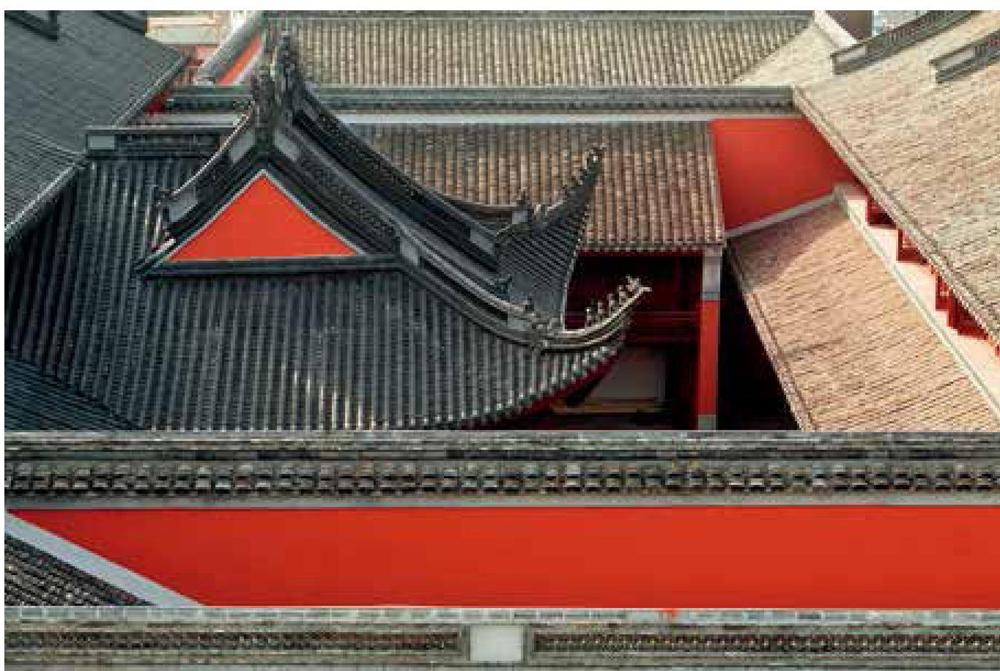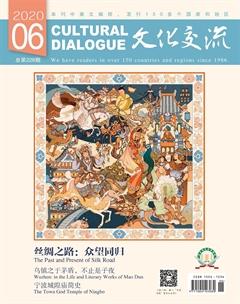宁波城隍庙简史
周东旭



宁波是一个港口城市,自唐宋以来,日本、朝鲜等国家的人,或多或少在这个城市留下遗迹或记述。
宁波府城隍庙,又称宁波郡庙,始建于明代,是我国目前保存完整、现存规模最大的城隍庙之一,是宁波历史文化地标性建筑,在宁波地区可谓家喻户晓。千年的历史长河里,郡庙是宁波古城文商并荣的象征。
宁波城隍庙充满了丰富多彩的市井民俗风情,是宁波一代人的记忆。岁月流逝,老庙亦在岁月中变得沧桑深沉。从2018年10起,城隍庙开始进行修缮,目前工程已完工,可谓涅槃重生。
庙中之庙,历史悠久
明太祖对大学士宋濂说:“朕立城隍神,使人知畏,人有所畏,则不敢妄为”。大概是因为皇帝的推崇、皇权的力量,所以城隍信俗起源虽然历史悠久,但在明代开始就遍地开花。就宁波而言,府有府城隍庙,县有县城隍庙,更有特色的是宁波是沿海城市,所以明代的时候,宁波东南沿海设了许多卫所,由南至北依次为:昌国卫、石浦前后二所、爵溪所、钱仓所;定海卫(即镇海)、大嵩所、郭巨所、穿山后所,观海卫、龙山所;临山卫、三山所。凡有城处,均须设城隍庙,所以这些卫所里均设有城隍庙。经历岁月的洗禮,这些地方还保存了不少文物级别的城隍庙,如石浦城隍庙就因为建筑宏伟、体量完整而得到保护。
在宁波三江口立城之前,宁波区域还有“鄞、鄮(mào)、句章”古城,白杜古鄞城就有城隍庙,鄮城在东乡同岙,按老地图上的标记也有城隍庙,所以这样一来,整个宁波区域大大小小就有20多个城隍庙。虽然年代久远,风流总被雨打风吹去,有些古庙建筑荡然无存,有些易地重建,有些保留了一些断壁颓垣,供人凭吊,有些则修复后气势雄伟,列入文物保护,供人瞻仰游览。
宁波境内现存的城隍庙建筑,以宁波府城隍庙建筑最为宏大有特色。宁波城是宁波的府城,也是旧时鄞县县城,所以城中有两个城隍庙,而且距离也不远,一个在大梁街,一个在县学街,相差不过两百米。但据老百姓的回忆,县城隍庙无法和郡庙相比,现在县庙已荡然无存,据说先前办过小学,后来拆除后造了一座大楼,现今大楼的后墙上嵌着八块石碑,大都是“勒石永禁”类的官府告示碑,没有人去理会这些古碑上的故事,爬山虎绿葱葱的盖过古碑,掩盖了过去的辉煌。
民间艺术,异彩纷呈
旧时代的城隍庙,用现代的话说,是一个大型文化综合体。以城隍信俗为基础,结合文化、经济、商业,是市井文化的载体。古建筑有文物价值,雕刻精美有欣赏价值,神像是民间艺人留下的雕塑艺术,摆设、装饰无不融合了现今的许多非物质文化遗产项目技艺。宁波的许多庙宇建筑大半金碧辉煌,大都是因为宁波四大艺术之首的“朱金木雕”——雕刻好的花版构件,底色是赤朱色的,部分图案贴上金箔,闪闪发光,历久弥新。从这个角度说,城隍庙可谓是宁波传统工艺的展示馆。
城隍庙有戏台,演出过京剧(徽班)、绍剧(绍兴大班)、越剧(的笃班)、甬剧(宁波滩簧),它是一个开放式的剧场,老百姓名为酬神,实为娱乐,“铜锣响,脚底痒”,不光周边的居民听到锣鼓声响会来凑热闹看戏,十里八乡的村民也会闻风而来。台上的一招一式、一唱一和,像磁石一样吸住了台下的观众。听到丑角的插科打诨,台下不觉发笑;看到奸臣害忠良时,台下又是咬牙切齿的喝骂;悲旦大段地演唱时,不少老妪暗暗抹去眼角的泪水。看戏人亦在戏中。
除了戏曲外,还有戏曲的同胞兄弟曲艺的演出。宁波的三大曲艺“南词、走书、评话”,尤以走书和评话最吸引人。南词被称为“文书”,比较文雅,适合厅堂演出,大户人家,安安静静,听个开篇或全部《玉蜻蜓》《珍珠塔》,故事也是才子佳人,风流韵事。走书,则有“武书”之称,宁波人形容,一个人绘声绘色说话连带肢体动作,就说像在“讲武书”。走书与评话的区别在于走书是带把大胡琴的,演出时需要演唱,评话则不用。宁波评话最著名的艺人张少策,现今年近九旬,还能登台演出。他说的《武松打虎》是非常有名的一个段子,也是一代宁波人的记忆。
提起宁波城隍庙,许多人的印象都会和小吃城挂上钩,什么炸鹌鹑、牛肉细粉、汤团、馄饨、炒年糕等等。城隍庙旧时有许多小吃,以庙兴市,热闹非凡。后来在20世纪80年代,郡庙维修后,就专设了城隍庙美食城,两厢设了许多日用百货店,所以当代人对宁波城隍庙的记忆都是小吃购物,但后来就渐渐觉得,百年老庙房梁上水气氤氲,石板地上漫着厚厚的油污,对老庙不安全,也不见得卫生。许多文保人士痛心于这个文物建筑被小吃城占据。经过专家的论证,最后把美食城移出来,设立在周边的现代建筑中。
还原城隍庙本来的样子。这也是这次维修的初衷吧。
海丝文化,港城留痕
宁波是一个港口城市,自唐宋以来,日本、朝鲜等国家的人,或多或少都在这座城市留下遗迹或记录。宁波的东门口一带,原先还有一个叫波斯巷的巷子,居住的就是阿拉伯人。在宋代,大街上也能碰见金眼碧发的外国人,这在宁波一点也不稀奇怪,至于日本人则更多。
日本高僧策彦周良,1539年(明嘉靖十八年)为遣明副使入明,1547年为遣明正使再度入明,受明世宗召见,并赐唱和诗。在明时,与文人广泛交往,著有《初渡集》《再渡集》。
在《初渡集》中,他涉及城隍庙的记载有三处,分别是宁波府、淮安府清河县和北京的城隍庙。嘉靖十八年(1539年)6月25日,策彦参观了宁波的城隍庙:
“谒城隍庙。庙里塑北斗星君之像,像前有牌,书“宁波府城隍之神”七字。各献香资者一缗。”
据方志记载,宁波城隍神供奉汉初大将纪信,而策彦周良的记录里为北斗星君,可见当时的庙中也供奉了北斗星君,那城隍神则有神主牌代替,大概在一段时间流行过以神主牌代替神像。
冈千仞(18331914年),字振衣,号鹿门,原仙台藩士,他精通汉学与西学,日本明治维新后,曾任修史馆编修官,东京府书籍馆干事等职,后因对藩阀专制不满而辞官办塾,名绥猷堂,前后有“弟子三千”。
1884年,冈千仞来华游历一年,行程万里,会见官员文士二百人,包括李鸿章、张之洞、盛宣怀、李慈铭、俞樾、袁昶、沈曾植、龚易图等,极力主张中国变法图强。他来时带有自己著作,当时的《申报》报道:“日东文豪某,携著书千卷,为中土山水之游。”冈千仞也说,“故此游捆载各种诸书,将就正大方君子也”。后遇在汉口开日文书店的三河静修,劝他游长江一线,冈千仞有意访游,立刻“因付著书数部,令为名士先容”。一路上获赠书143种,自购128种,共达1829卷。他以日记体把在华旅程写成《观光纪游》:
“1884年七月廿九日(六月八日)
平明,逾一坝出甬江。峨舸大艑,水面为陆,一望知其为大埠。与静庵观市街,抵城隍庙。神像端冕,左右四像,其一戎装手剑,其一衣冠手册,威棱如生。庙前设演剧台,两庑回楼,为待观客之处,壁录鉴戒之语。男女群诣,肩与肩摩,比我浅草大悲堂更为闹热。唯丐徒贱隶踞地赌博,大觉杀风景。
转观天峰塔,积砖瓦筑成,矗立七层,每层两梯。攀至第六层,下临惴惴,不觉目眩。东南见群岛蜿蜒海上,为补[普]陀洛山。闻岛有巨刹,本邦僧所开。更转入城壁,此为鄞县。观城隍庙,雕镂精致,比前更煥。”
冈千仞参观了宁波城中的府县两个城隍庙及天封塔。冈千仞觉得宁波府城隍庙比东京的浅草寺更为热闹,只是当时许多闲杂人等聚众赌博,让他感到很煞风景。然后,他又参观攀登了宁波当时城中的最高建筑天封塔,随后又去看了县城隍庙,觉得县城隍庙比府城隍庙的雕刻更精美。这或许只是他的豹窥一斑,从现存的记忆和文献中,鄞县城隍庙的规模和雕刻远不如府城隍庙。不过从《申报》中的记录来看,光绪九年(1883年),府城隍庙遭遇火灾,部分建筑烧毁,直到1887年,才修完城隍庙。或许冈千仞看到的只是维修中的城隍庙吧。
日本著名汉学家青木正儿在他的《中国近世戏曲史》中曾经提起宁波府城隍庙的戏台,称这是他见过的“地基最高的戏台”。地基建得高是为了让更多观众更好地欣赏演出,可见当时宁波府城隍庙的规模之大、人气之旺。青木正儿见到的城隍庙戏台,应该正是1887年维修后的古戏台。
The Temple of Town God of Ningbo, first constructed in the Ming Dynasty (1368-1644), is one of the best preserved and largest city god temples in China. A historic landmark and pride of place in the harbor city in eastern Zhejiang, the temple has witnessed the citys cultural and material prosperity. Now under a refurbishment project since October 2018, the temple is expected to reopen soon if and when the Covid-19 pandemic is under tight control.
Though the faith in the town god can go back to a long time ago, town god temples mushroomed in the Ming Dynasty after Zhu Yuanzhang, the founding emperor of the dynasty, decided to enhance the status of the town god in the country in a bid to maintain law and order in the newly founded dynasty. Inside the city of Ningbo, there were town god temples at the prefecture and county levels. Moreover, all the coast guard garrison towns along the coastline of Ningbo had their own town-god temples. Some of these temples have remained. An ancient map of Ningbo indicates that there were as many as 20 plus town god temples across Ningbo at the time the map was made. A prefecture, Ningbo had its own town god temple, which remains today. However, as the prefecture government was located in Yinxian County, the countys town-god temple stood only about 200 meters away from the prefectures counterpart. The countys town-god temple disappeared not a long time ago, replaced by a stately building. The only mementos that indicate the glory of the lost temple are eight stone steles now embedded in the back wall of the building. The steles are from the disappeared town god temple of Yinxian County.
For a long time, the town-god temple of Ningbo served as a huge entertainment and shopping center of the city. Architecturally, the structure is a showcase of woodcarving in red and gold, a well-known craft of Ningbo. The temple features a great number of such woodcarvings covered with gold foils on the reddish background. There is a theater stage inside the temple. Open to the public, the theater is a venue for performances in honor of the town god. Plays of various regional opera genres are performed there. Story-telling is also a popular public entertainment at the temple. The temple theater boasts three kinds of story-telling styles. One is relatively quiet, especially appropriate for romances. Another story-telling format is appropriate for stories about heroes who vanquish evils and bad guys and help the disadvantaged people. The temple was a center of folk entertainment and this part of the entertainment is expected to continue.
For some people, the town god temple of Ningbo was a paradise for gourmets. All kinds of local delicacies were available to pilgrims, tourists, and other visitors. Foodies were pleased especially with temple fairs when there were all kinds of food provided. In the 1980s, the temple went under a reconstruction and a large food court was set up on the compound and a row of shops flanked the either side of the food court. In the memory of many people of today, the town-god temple was where you went shopping and enjoyed local delicacies. But experts and scholars disliked the food court and shops inside the temple. So in the refurbishment project started in October 2018, all the food stalls and shops were relocated to buildings around the temple. There will be no food court and shops inside the temple after the reopening. The idea behind the new arrangement is: let the temple remain what it was before the modern times.
Ningbo in ancient times was an important port city for international trade. It was especially important for the commercial and cultural ties between China and Japan. Sakugen Shūryō (1501–1579), a Japanese monk who visited China twice as a diplomatic emissary, came to Ningbo in his first journey to China on June 25, 1539. The monk visited the town-god temple in Ningbo and paid homage to the town god. He mentioned three town-god temples respectively in Ningbo, Huaian and Beijing in his travelogue on his first visit to China. Apparently, he crossed the sea and landed at Ningbo and traveled northward on the Grand Canal.
Oka Senjin (1833-1914), a prominent Japanese sinologist, spent a year in 1884 traveling through China and met with over 200 Chinese government officials, business tycoons and scholars including Li Hongzhang, Zhang Zhidong and Sheng Xuanhuai. He kept a diary on his adventure in China. One entry dated July 29, 1884 is about his visit to the town-god temple of Ningbo. Oka Senjin visited two town-god temples in Ningbo and ascended the Tianfeng Pagoda, the tallest structure in Ningbo of that time. The Japanese visitor was deeply impressed by the grandiose of Ningbos town-god temple and by the hustle and bustle of the theater, but felt sorry that the sight of some gamblers there was a killjoy.
Aoki Masaru (1887-1964) mentioned the theater stage on the compound of the town-god temple of Ningbo in , a book he authored. He said the theater stage was perched on the tallest foundation he had ever seen.

